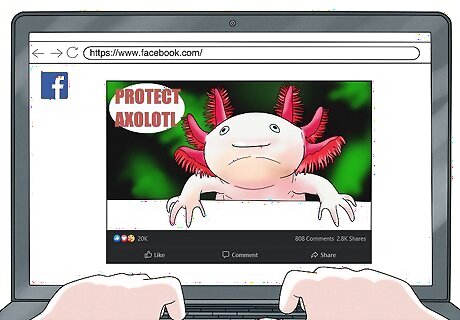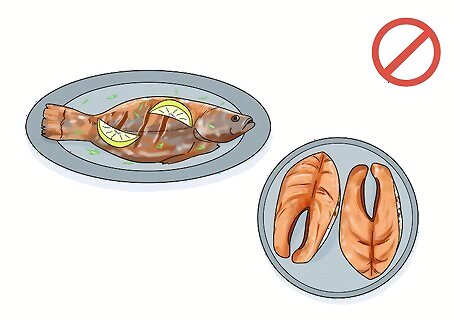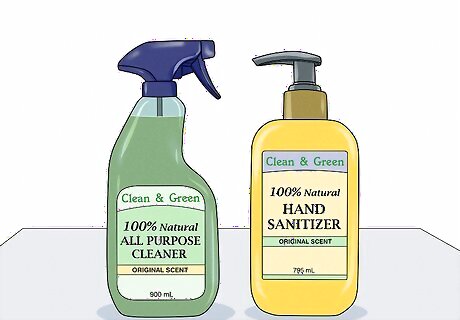
views
X
Research source
Despite their low numbers in the wild, they’re often bred in captivity and sold as pets around the world. These fascinating creatures have also caught the eye of scientists due to their ability to perfectly regenerate limbs and organs with ease. Even if you don’t live near the only wild habitat they have left (Xochimilco, Mexico) you can help protect them from home with your actions, voice, money, and time.
Advocating for Axolotls

Educate others about the importance of axolotl conservation. Post articles and news stories on social media about the importance of protecting axolotls and their habitat. Provide links to reputable charities and sites so friends, family, and acquaintances can read about them from credible sources. You might also include links to various charities and conservation groups that people can support. Consider hosting a fundraising party and inviting your friends, family, and neighbors over to spend an evening learning about axolotls and how they can help. Share some cool facts about axolotls like how they can breathe through their skin or how they can perfectly regenerate their limbs, organs, spines, brains, and other body parts 100 times over! If you’re a teacher, parent, or big sister, look up a variety of fun activities you can do to teach children about these adorable and fascinating amphibians. You can find worksheets, games, and fun videos online just by searching “axolotl activities for kids” or “axolotl children education.”

Discourage the pet trade that decreases axolotl’s genetic diversity. While it's tempting to want one of these cute amphibians in your home, don't keep them as pets. Instead, consider putting the money you would have spent on caring for the axolotl towards conservation groups and environmental protection organizations. Less genetic diversity means a species is much more susceptible to disease, pests, and other stressors. This means 1 strain of disease could wipe out the entire species. If you already have a pet axolotl, treat it well. If somebody asks about your pet, take the opportunity to fill them in on why they’re important and how they can help protect wild axolotls. If you come across anyone selling axolotls as pets in California, Maine, New Jersey, or Virginia, report them to the US Fish and Wildlife Service.

Donate money to an axolotl conservation group. Look up "axolotl conservation group" or "save axolotls charity" and read a little about what they're doing to help protect axolotls. Give however much you want to help fund research and expeditions to conserve their livelihood. Make sure to choose a nonprofit organization that’s 501(c)(3) certified so you know 100% of the funds are going towards conservation. Axolotl Science Outreach, Earthwatch Institute, World Wildlife Fund, World Land Trust, and Caudata.org are all places where you can donate to protect axolotls and their habitat.

Launch your own fundraiser to collect money for a conservation group. Start a campaign on Kickstarter or GoFundMe and share it with friends and family over social media platforms to spread the word. Include some research on the page about the axolotl population and why saving them is near and dear to you. For instance, you might call the campaign “Axolotl Habitat Preservation” and explain that all proceeds will be going towards the Earthwatch Institute’s habitat protection program.

Vote for politicians who consider wildlife conservation to be a priority. Do your research before each local, state, and national election to see who supports wildlife conservation. Even if they don’t specifically mention wildlife conservation in their campaign, big-ticket items like curbing global warming, pollution, and limiting the use of fossil fuels make a huge difference. If you’re not sure about a particular candidate’s stance, send them a letter asking if they support the Endangered Species Act and plan to provide more funding for the Land and Water Conservation Fund.

Get involved with a conservation group or habitat rehabilitation center. Contact conservation groups or wildlife habitat research centers online and ask how you can help contribute to their efforts. Let them know of any special skills you have that may be of benefit. If you’re currently looking for a new job, see if various wildlife conservation organizations have any openings. They might need someone to write press releases, manage their website, do outreach, or coordinate events to help the cause. Working with a conservation group might mean writing letters or making phone calls to city agencies or developers about preventing urban development around Xochimilco. For example, if you're a graphic designer, you might offer to create a logo for their latest campaign. If you have writing or editing experience, you might write press releases or educational articles. If you’re a programmer, you might help them manage their website.

Take a volunteer trip to Xochimilco for a more hands-on approach. If you’re currently enrolled in a college or university, contact the biology department to see if they have study abroad opportunities where you can go to Xochimilco and provide some hands-on support. You can also contact the biology department at universities in and around Mexico City to ask about opportunities regarding axolotl habitat conservation. The kind of work you might be doing ranges from cleaning up wetlands where axolotls live, planting trees and vegetation to prevent contaminated runoff from nearby farms, installing wooden gates to separate invasive fish from axolotl populations, and tracking the axolotl population in certain areas. Xochimilco is located 40 minutes (by car) south of Mexico City, so be prepared for a drive if you choose to stay in Mexico City during your volunteer trip. The Metropolitan Autonomous University (UAM) in Xochimilco is a great place to ask about hands-on opportunities.Fun Fact: The Aztecs built small garden islands (called chinampas) that created a perfect environment for axolotls to thrive. Building these gardens from logs and mud from the lake bottom just might be something you can help do on your volunteer trip.
Changing Your Habits

Stop eating fish to lower the demand for artificial farming. Don't buy fish like Asiatic carp and tilapia from markets or eat them at restaurants to help decrease demand and cut back on artificial farming practices. Encourage your friends and family to do the same to make a larger impact. If you want to help all animals, including the axolotl, consider replacing fish with vegan alternatives like tofu, seitan, or tempeh. Asiatic carp and tilapia, 2 big predators of the axolotl, are often artificially introduced into habitats where axolotls live.

Use all-natural products in your home. Only use products that don't contain pollutants like ammonia and heavy metals because these chemicals can get washed into wetlands where axolotls live. When you're buying cleaning supplies and self-care products, look for "organic,” “plant-based,” or "all-natural" on the label. Check the back of the package or bottle to make sure it's recyclable and free of harsh chemicals. If you live in an area upland from the Xochimilco canals, this is especially important because gravity can carry toxic chemicals a long way via rain and sewer runoff. If you don’t want to buy natural cleaners, you can make your own using ingredients you probably already have. Some of the worst home cleaning and care products are: Microbeads (found in some face washes, scrubs, toothpaste, and abrasive cleaners) Wet wipes Aerosol cans Detergents containing phosphates Chlorine-based bleach

Don’t use disposable plastic products and recycle whenever you can. Skip the plastic bags at the store and bring your own reusable totes. Try to avoid buying foods that are sold in plastic containers that may end up polluting the air, land, and water later on as they’re burned or transported to a dump. If you can’t avoid plastic containers, make sure they’re recyclable. Check the number on the bottom of the containers to see exactly how you should recycle the plastic so you know it won’t end up in a landfill. Even if you live far away from axolotl’s natural habitat, little changes like this make a big difference because air, land, and water pollution can impact other places hundreds of miles away.Fun Fact: Axolotls breathe through their skin and gills (the plumage around their heads), so the quality of the water they’re in is extremely important to their health.

















Comments
0 comment